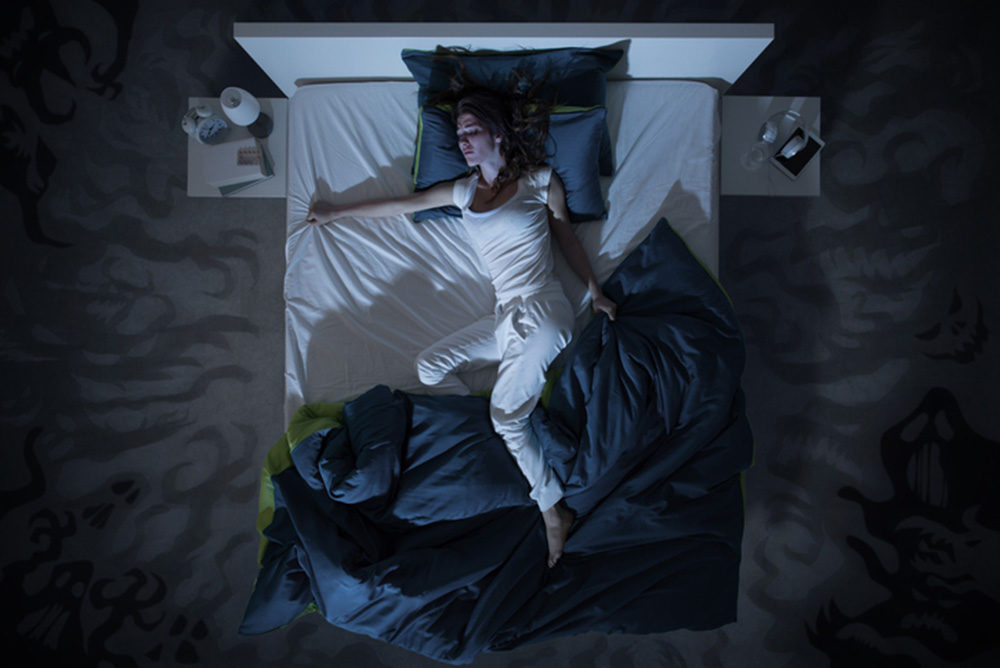
iStock
AN ADULT who mentions night terrors usually gets the same two questions: You mean, like nightmares? Or, aren’t children the only ones who have those? For adults, the same questions lead to general confusion and often to misdiagnosis. Other misconceptions trace the terrors to Satan and other demons; and, especially among veterans, to post-traumatic stress disorder (PTSD).
Compared to nightmares, night terrors usually have no content and can be dangerous. They can include sudden nighttime awakening, screaming, sweating and flailing, along with persistent fear, terror and confusion. Sufferers may hit or throw objects and can also sleepwalk, with inherent dangers such as walking into things and “using kitchen appliances.”
Night terrors can last from a few seconds to 20 minutes, and can occur at any age from an hour after birth to death. Prevalence is estimated at 1-6% in children, although recurrent episodes are less common; and less than 1% for adults, according to the DSM IV.
Sleepers remain asleep, although their eyes may be open. Once semi-awake, some people see frightening images like spiders and snakes in the room. But they are unable to wake up fully and are difficult to comfort. On awakening, sleepers have no memory of the terrors.
Night terrors occur during deep, Stage 4, non-REM sleep, which begins close to an hour after falling asleep. In contrast, nightmares occur during REM sleep, the dream phase—which begins later in the sleep cycle, usually about 90 minutes after falling asleep—during which most body muscles are paralyzed. When nightmares occur in clusters, called nightmare disorder or dream-anxiety disorder, “there is complete alertness and recall of dreams on waking.” These nightmares are associated with extreme anxiety and often related to previous trauma that is relived in the dreams, and are a major symptom of PTSD.
Night terrors are one of many non-REM parasomnias, also called disrupted sleep-related events, “undesired occurrences during sleep,” and “disorders of arousal,” which occur when the person is in a mixed state of being both asleep and awake—awake enough to act out complex behaviors but asleep, and unaware of and unable to remember their actions.
The timing of night terrors in Stage 4 differentiates them from the parasomnia common sleep paralysis —waking without being able to move or speak —which occurs during Stage 1. (The related hallucinatory, or hypnagogic, sleep paralysis has also been traced to evil spirits.)
Another parasomnia is nocturnal seizures, causing the sleeper to cry, scream, move about or curse. And sleep starts, like the sudden jerk that can occur while falling asleep, are visual or auditory sensations that seem to come from inside the head.
Included among “confusional arousal disorders” (in which the higher reasoning centers of the cortex are deactivated while more primitive activities like sex and eating are disinhibited) are variations of sleepwalking, such as sleep-related eating disorders. Another somnambulistic sexual behavior —also called sexsomnia or sleep sex —is an automatic behavior, in contrast to motor activity during a dream. Episodes of sleep-related eating and sexsomnia may affect up to 5% of adults.
Night terrors are more common among family members, suggesting a genetic component. In sleep lab research, they are linked to increased brain activity or “misfiring.” Adults suffering from any of the arousal disorders should seek evaluation, because these could be triggered by heartburn, limb movements during sleep and sleep apnea, all of which affect quality of sleep and often cause daytime drowsiness.
The best research-based treatment for night terrors, found to cure 9 out of 10 children, is “scheduled awakening therapy”—interrupting the sleep cycle every 15-30 minutes. Created using research from Stanford University, a device called the Lully Sleep Guardian monitors individual sleep patterns and emits gentle vibrations when night terrors are most likely to occur—and then turns them off when the sleeper stirs.
Because night terrors are often related to increased stress and fatigue, more and better sleep (longer hours and regular wake times) can be the best cure for children, but also for adults.
—Mary Carpenter
Every Tuesday in this space, Mary Carpenter reports on the state of our well-being.
